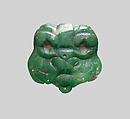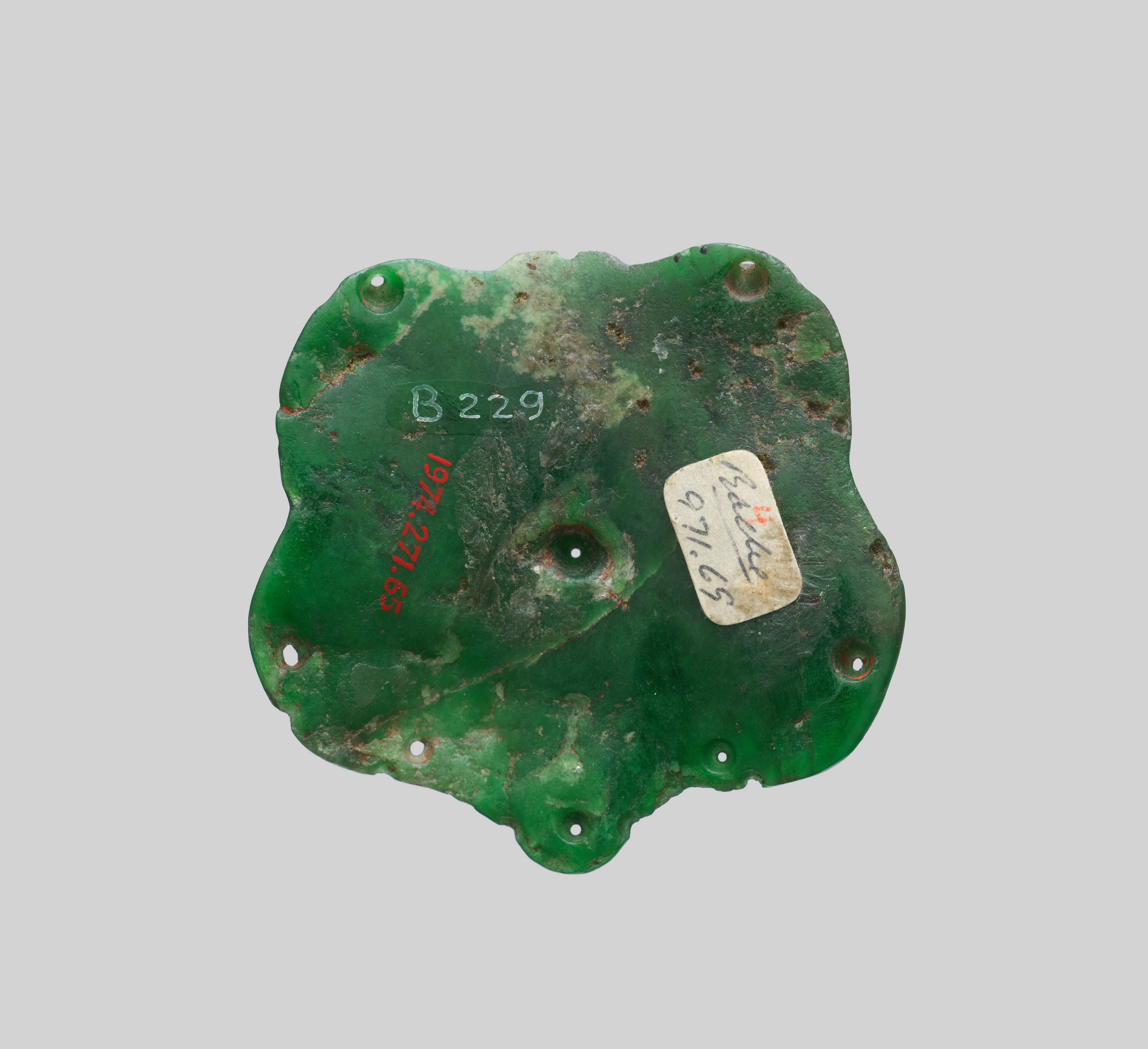Duck-Face Ornament
Not on view
This exquisite pendant made of high-quality translucent blue-green jadeite portrays an avian entity with a pointed duckbill. The artist portrayed the waterbird in frontal view, skillfully modeling the contours of the large eyes, nostrils, and beak; incised lines indicate the margins of the bill. A raised central portion that extends upward from the forehead may represent a feathered crest. Eight conical drill holes from the reverse side pierce the line of the bill, the center, and the upper left and right of the pendant. Affixed with fibers through these holes, the pendant likely formed part of an assemblage of jade beads as a centerpiece in ceremonial regalia. Traces of red pigment in the recesses of the relief and drill holes suggest that this treasured object also comes from a funerary context.
Ducks and other waterfowl were revered by ancient Mesoamerican peoples for their ability to cross between the realms of the sky, the earth, and underwater places. Several examples of Olmec and later Isthmian art, such as the Tuxtla Statuette, portray duck-billed characters, as if in a state of transformation into avian characters. Later Maya and Aztec deities with duck-billed visages were personifications of wind and sacred breath.
Further reading
Benson, Elizabeth P., and Beatriz de la Fuente, eds. Olmec Art of Ancient Mexico. Washington, D.C.: National Gallery of Art, 1996.
Berrin, Kathleen, and Virginia M. Fields, eds. Olmec: Colossal Masterworks of Ancient Mexico. San Francisco: Fine Arts Museums of San Francisco, 2010.
Cheetham, David, and Jeffrey P. Blomster, eds. The Early Olmec and Mesoamerica: The Material Record. Cambridge: Cambridge University Press, 2017.
Clark, John E., and Michael Blake El origen de la civilización en Mesoamérica: Los Olmecas y Mokaya del Soconusco de Chiapas, Mexico. In El Preclásico o Formativo: Avances y perspectivas, Martha Carmona Macias, ed. Museo Nacional de Antropología, México City, 1989, pp. 385–403.
Clark, John E., and Michael Blake The Power of Prestige: Competitive Generosity and the Emergence of Rank Societies in Lowland Mesoamerica. In Factional Competition and Political Development in the New World, Elizabeth M. Brumfiel and John W. Fox, eds., Cambridge: Cambridge University Press, 1994, pp: 17– 30.
Clark, John E., and Mary Pye, eds. 2000 Olmec Art and Archaeology: Social Complexity in the Formative Period. Washington, D.C.: National Gallery of Art.
Coe, Michael D. The Jaguar’s Children: Pre-Classic Central Mexico. New York: Museum of Primitive Art, 1965.
Coe, Michael D. The Olmec Style and Its Distributions. In Handbook of Middle American Indians, vol. 3 (Robert Wauchope, gen. ed.). Austin: University of Texas Press, 1965, pp. 739–775
Coe, Michael D. (ed.) The Olmec World: Ritual and Rulership. Princeton: The Art Museum, Princeton University, 1996.
Coe, Michael D., and Richard A. Diehl In the Land of the Olmec: The Archaeology of San Lorenzo Tenochtitlán, 2 vols. Austin: University of Texas Press, 1980
Covarrubias, Miguel Origen y desarrollo del estilo artístico “Olmeca.” In Mayas y Olmecas: Segunda reunión de Mesa Redonda sobre problemas antropológicos de México y Centro América. Mexico City: Talleres, 1942, pp. 46-49.
Cyphers Guillén, Ann From Stone to Symbols: Olmec Art in Social Context at San Lorenzo Tenochtitlán. In Social Patterns in Pre-Classic Mesoamerica (David C. Grove and Rosemary A. Joyce, eds.), Washington, D.C.: Dumbarton Oaks, 1999, pp. 155–181.
Drucker, Philip La Venta, Tabasco: A Study of Olmec Ceramics and Art. Smithsonian Institution, Bureau of American Ethnology, Bulletin 153. Washington, D.C.: Government Printing Office, 1952.
Drucker, Philip, Robert F. Heizer, and Robert J. Squier 1959 Excavations at La Venta, Tabasco, 1955. Smithsonian Institution, Bureau of American Ethnology, Bulletin 170. Washington, D.C.: Government Printing Office, 1959.
Easby, Elizabeth Kennedy, and John F. Scott Before Cortés: Sculpture of Middle America. New York: Metropolitan Museum of Art, 1970, no. 48.
Feuchtwanger, Franz Ceramica olmeca. Mexico City: Editorial Patria, 1989.
Grove, David C. Olmec: What’s in a Name? In Regional Perspectives on the Olmec (Robert J. Sharer and David C. Grove, eds.): Cambridge: Cambridge University Press, 1989, pp. 8-14.
Jones, Julie, and Susan Mullin Vogel. Notable Acquisitions (Metropolitan Museum of Art) (1965–75), pp. 171–83.
Joralemon, Peter David A Study of Olmec Iconography. Studies in Pre-Columbian Art and Archaeology 7. Washington, D.C.: Dumbarton Oaks, 1971.
Magaloni Kerpel, Diana, and Laura Filloy Nadal La Ofrende 4 de La Venta: un tesoro olmeca reunido en el Museo Nacional de Antropología. Mexico City: Instituto Nacional de Antropología e Historia, 2013.
Michelet, Dominique, Cora Falero Ruiz, and Steve Bourget Les Olmèques et les cultures du golfe du Mexique. Paris: Skira, 2020.
Pool, Christopher A. Olmec Archaeology and Early Mesoamerica. New York: Cambridge University Press, 2007.
Reilly, Frank Kent, III The Shaman in Transformation Pose: A Study of the Theme of Rulership in Olmec Art. Record of the Art Museum, Princeton University vol. 48 no. 2, 1989, pp. 4–21.
Taube, Karl A. Olmec Art at Dumbarton Oaks. Washington, D.C.: Dumbarton Oaks, 2004.
Due to rights restrictions, this image cannot be enlarged, viewed at full screen, or downloaded.
This artwork is meant to be viewed from right to left. Scroll left to view more.



